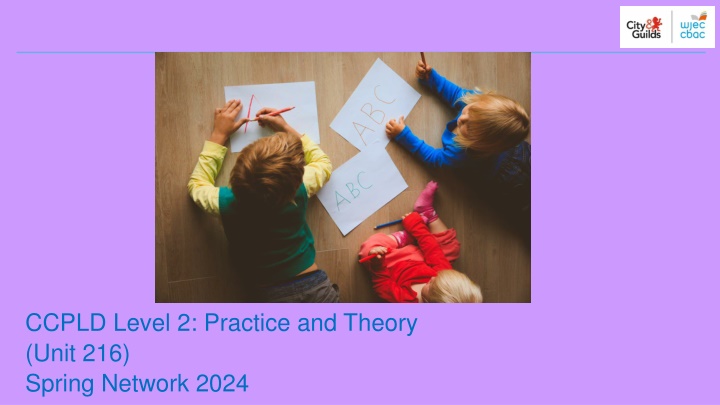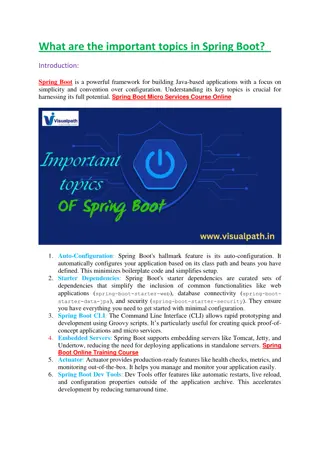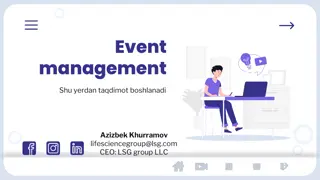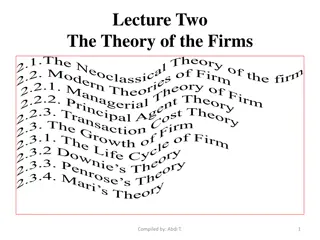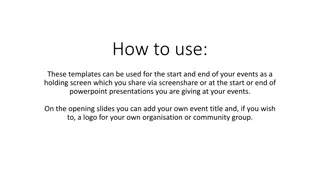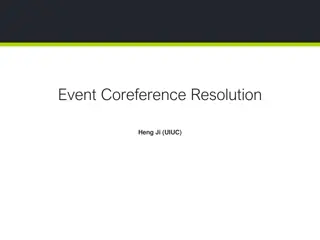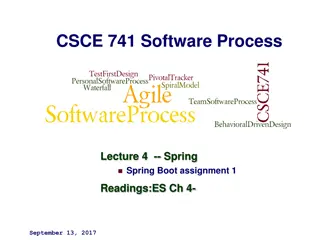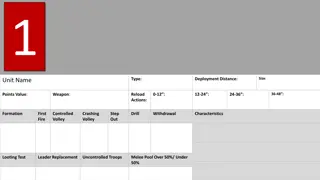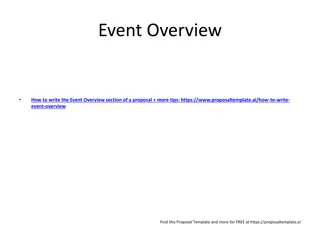CCPLD Level 2: Practice and Theory Unit 216 Spring Network 2024 Event Details
This event discussing CCPLD Level 2 Practice and Theory Unit 216 for 2024 is supported by representatives from WJEC and City & Guilds. It includes audio recording guidelines, the use of Teams, and the distribution of event materials. Participants can engage in discussions and receive feedback from the Principal Examiner. Adherence to protocols like muting mics, using chat functions, and resolving technical issues is encouraged for a seamless experience.
Download Presentation

Please find below an Image/Link to download the presentation.
The content on the website is provided AS IS for your information and personal use only. It may not be sold, licensed, or shared on other websites without obtaining consent from the author.If you encounter any issues during the download, it is possible that the publisher has removed the file from their server.
You are allowed to download the files provided on this website for personal or commercial use, subject to the condition that they are used lawfully. All files are the property of their respective owners.
The content on the website is provided AS IS for your information and personal use only. It may not be sold, licensed, or shared on other websites without obtaining consent from the author.
E N D
Presentation Transcript
CCPLD Level 2: Practice and Theory (Unit 216) Spring Network 2024
This event is supported and facilitated by representatives and subject specialists from WJEC and City & Guilds. WJEC Amy Allen-Thomas City & Guilds and WJEC continue to work collaboratively and in partnership with the following organisations who will also be contributing to this event: Subject Officer Children s, Care, Play, Learning and Development Qualifications Wales Social Care Wales Health Education and Improvement Wales Level 2 CCPLD: Core Level 2 CCPLD: Practice and Theory Level 3 CCPLD: Practice and Theory WJEC Sian Bevan Principal Examiner Children s, Care, Play, Learning and Development Level 2 CCPLD: Practice and Theory
Audio Recording The presenter is required to make an audio recording of this event. This is a control designed to ensure that WJEC is able to demonstrate compliance with regulatory Conditions of Recognition; specifically, conditions relating to the confidentiality of assessment materials. The recording will be made available to the qualifications regulator if required, but it will not be shared with any other third parties. The recording will be stored securely by WJEC for a period of three years and then permanently destroyed. Please note that delegates are NOT PERMITTED to make an audio or video recording of any aspect of this event.
Using Teams During this Teams session, it would be beneficial to all if the following protocols are adhered to: Microphones to be muted when not speaking Use the raise your hand feature to ask a question or use the chat function Activate your camera if you wish to do so Technical problems: If you experience technical problems with your sound or your web camera, this is often out of our control, but in the first instance we advise you leave and re-join the meeting or contact your own IT support.
Event Materials This PPT presentation will be sent to the email address(es) you provided on registration.
Aim and objectives The online session will provide participants with an opportunity to: Listen to high level Principal Examiner feedback on Unit 216 from January 2024 examination. Read and digest candidates responses before the session and propose awarded marks in line with mark scheme in preparation. Participate in discussion for each marked response. Gather hints and tips on the marking process to embed in delivery and assessment at centre level. Question and answer opportunities with the technical adviser and subject specialists. New Mailbox for WJEC CCPLD Qualifications CCPLD@wjec.co.uk
January 2024 Paper 24 Onscreen 176 Number of entries Pass mark: 30/70
January 2024 Support Pack
Winter 2024
Principal Examiner Feedback January 2024
High level feedback The content of this paper presented a range of question types covering the content of Unit 216 as set out in the specification. Application of knowledge and understanding was attempted in some of the answers presented. However, it appeared that some learners found this difficult in places. Additions or changes made to the mark scheme during conference contributed to positive marking allowing additional marks to be awarded using the credit any other response guidance. Only some learners attempted to answer all questions whilst leaving some questions blank. This indicated limited understanding of some areas of the specification. Although there was a general understanding of command verbs some learners lost valuable marks where command verbs were not followed resulting in bullet pointed responses. Once again, those candidates completing online papers were able to extend their responses and gain higher band marks in many instances. Several examiners experienced difficulty reading handwritten papers which could have contributed to the awarding of lower marks.
Unit 216 Understanding Childrens Care, Play, Learning and Development
Command Verb: Explain Provide details and reasons for how and why something is the way it is Question 1(b) and mark scheme Award up to 4 marks Award 0 marks where response is not creditworthy Award 1mark for a basic explanation showing limited knowledge and understanding of how pretend play can promote the holistic development of children. Award 2-3 marks for a good explanation showing some knowledge and understanding of how pretend play can promote the holistic development of children. Award 4 marks for a very good explanation showing sound knowledge and understanding of how pretend play can promote the holistic development of children. Response may refer to: supports development and sharing of ideas enables expression of ideas which supports communication offers opportunity for problem solving and development of reasoning skills encourages children to work practically and discover what works develops new vocabulary supporting discussion and opportunity for thinking children learn about themselves and the world around themselves and the world around them supports exploration of frightening or worrying experiences children learn to negotiate and consider others perspectives transfer knowledge from one situation to another enables children to read social cues enables recognition and regulation of emotions, children will be able to negotiate and take turns allows children to develop imagination and creativity encourages working together and co-operation This list is not exhaustive Credit any other relevant response
Question 1(b) Candidates answer with Principal Examiners comments Pretend play can help improve physical development by using their gross motor skills to use their legs to walk around , and also their fine motor skills to pick different types of things up during the play. It can increase their level of imagination(improving their intellectual skills) as they will be playing creatively either by themselves or with other people. Their language skills will be growing as they will be talking , an example of this would be playing house as roleplay and talking to other people to create the storyline. The childs' emotional development will also be being used in pretend play as the child will have different types of emotions for each scene of the pretend play. As a child is playing pretend play , their social loevel will highly increase as they will be talking to other peers , teachers or family members as they play in an imaginative story. Principal Examiner feedback The examiner has acknowledged the very good understanding shown by this learner in relation to the role of pretend play. Full marks are awarded for the explanation as the learner has developed the response in line with requirements. This can be seen where the explanation refers to each aspect of development in logical progression. The presentation of a response in this logical manner ensures consideration is given to the question as a whole and limits error or duplication. Marks awarded 4/4
Question 1(b) Candidates answer with Principal Examiners comments Pretend play will help with the childs intellectual skills as they are using their imagination and learning from what they know.The language skill of the child will be developed as the child will be communicating with their friends or asking adults questions which they are able to use throughout their pretend play. The childs emotional skill will also be developing as they are using what they know and expressing their feelings through role play. In addition to this their physical skills will also be developing as they are moving around for exmaple they will be walking around, could be running or jumping. Principal Examiner feedback Once again by separating the answer into relevant sections this learner has presented a response showing very good understanding of holistic development as the question requires. The explanation is supported at each stage with a brief example, such as using imagination to support intellectual development and expressing feelings to develop emotional skills. A well-deserved full marks awarded. Marks awarded 4/4
Command Verb: Explain Provide details and reasons for how and why something is the way it is Question 2(a) and mark scheme Response may refer to: bilingual children often find it easier to solve word problems bilingualism can support thinking and memory skills and an understanding of logic being bilingual can encourage further language learning as a third language becomes more easily acquired supports learning processes into adult hood and throughout life switching language develops a flexible approach to thinking skills supports better brain function and delays degenerative conditions such as dementia develops family and community relationships helps develop an understanding of other languages and cultures enables development of a range of friendship groups creates an understanding of equality and diversity provides improved communication experiences enabling better relationship building Allows access to an extended range of social activities offers outdoor opportunities that may not otherwise be accessible allows children to attend a range of physical activities with different peer groups outdoor/physical activities can be planned within a bilingual curriculum which will support a healthy lifestyle choice of language can support opportunities for enjoyment and fun whilst enhancing opportunities for physical development Award up to 6 marks Award 0 marks where response is not creditworthy Award 1-2marks for a basic explanation showing limited knowledge and understanding of how a bilingual environment supports holistic development. Award 3-4marks for a good explanation showing some knowledge and understanding of how a bilingual environment supports holistic development. Award 5-6marks for a very good explanation showing sound knowledge and understanding of how a bilingual environment supports holistic development. This list is not exhaustive Credit any other relevant response
Question 2(a) Candidates answer with Principal Examiners comments Bilingualy enviroment supports holistic development because bilingual children will be able to communicate with more people,givie them a wider range of frends, it will support the intellecrtual develpment as it will get the child thinking and improve there vocabulary,emotional development will be suppoerted because it will then become a inclusive enviroment this will help everyone express their feelings,the bilingual eviroment will als support holistic developments because the childs brain will develop quicker than someone who is not bilingual and they will feel feel supported while becoming bilingual this will grenurally support the hiolistic development as a whole. Principal Examiner feedback Falling at the top end of the middle band this learner has provided a good explanation. The command verb is met where the learner uses the word because or terms such as this will help/support to expand knowledge and understanding. To move to the top band the learner could have suggested more specific examples in relation to brain development as can be seen in the mark scheme. Marks awarded 4/6
Question 2(a) Candidates answer with Principal Examiners comments Bilingual enviroments are great for children in educational settings as they learn and develop their lingustic/language skills, they also will develop their social skills because theyll be able to interact with other children who may only be able to speak welsh and or english. They'll also be able to participate later on in their schooling wih certain fun-educational activities such as the eisteddfod which would develop a child in almost all areas. Intelectually, learning a new language supports development as their expanding their intake of knowledge and so are getting an even wider diverse education, and emotionally the children may learn about certain welsh history such as the welsh knott and the welsh settlements in Patagonia. Principal Examiner feedback This response has been awarded 4 marks again falling into the top end of the middle band. Although the learner has made reference to areas of development this is not clear in every aspect. Had the learner expanded and avoided the use of terms like in almost all areas additional marks may have been given particularly as links to historical events and emotional development are made which shows very good knowledge. Marks awarded 4/6
Command Verb: Outline Set out the main points/provide a brief description or main characteristics Question 3 and mark scheme Award 0marks where response is not creditworthy Award 1mark for a basic outline showing limited knowledge and understanding of a range of factors Charlie would need to consider when planning a wall display. Award 2-3 marks for a good outline showing some knowledge and understanding of a range of factors Charlie would need to consider when planning a wall display. Award 4 marks for a very good outline showing sound knowledge and understanding of a range of factors Charlie would need to consider when planning a wall display. Response may refer to: the theme in place in the reception class at the time the space available for the display the type of display needed e.g. wall/hanging/window/outdoor/table top/interactive display materials needed/available cost of any new materials need to be purchased location of displays accessibility for children children s participation and sharing of ideas age and stage of children to be considered for labelling purpose type of language to be used e.g. bilingual display durability of materials health and safety of materials used reading conventions when labelling This list is not exhaustive Credit any other relevant response
Question 3 Candidates answer with Principal Examiners comments When planning a wall display , Charlie will need to make it interesting so that the children will be drawn to it. For example this could be using bright colours , using big but also simple words so that the children can read and understand it (depending on their abilities). Charlie will also have to remember to mkae sure that it is relevent to the class topic or something that they have been or going to learn. Like i said , the children will have to be drawn to the wall display so Charlie will need to make sure that it is seen. The wall display could include pictures , bubble writing , and other fun creatve things like that to get the childrens' attention. Principal Examiner feedback The command verb requires learners to present and outline. This learner has met this requirement to a very good standard allowing full marks to be awarded. Several relevant points have been included with examples and/or reasons provided to support the ideas offered in the outline. This can be seen where the learner has suggested Charlie will need to consider the children's interest and how this might be achieved through using bright colours. Marks awarded 4/4
Question 3 Candidates answer with Principal Examiners comments Charlie would have to include children, for example if Charlie is putting up the year 1 class photo up on the wall for display he should also include all the other school years. Also Charlie would have to consider where to place the photos or work on the wall because if it is too high up on the wall some or most of the children wont be able to look at the display. He also has to consider what materials he would use to put it up on the wall, for example if he used glue that would be safe but if he used a stapler that could be a risk as it could fall onto the floor and a child stepping on it ending in injury. Principal Examiner feedback Once again, this learner has included suggestions to support the outline presented. A range of ideas are offered, and the understanding of inclusion indicates a high level of knowledge to support the awarding of full marks. Marks awarded 4/4
Command Verb: Outline Set out the main points/provide a brief description or main characteristics Question 5(a) and mark scheme Award up to 4 marks Award 0marks where response is not creditworthy. Award 1 mark for a basic outline showing limited knowledge and understanding of the United Nations Convention on the Rights of the Child Award 2-3marks for a good outline showing some knowledge and understanding of the United Nations Convention on the Rights of the Child Award 4marks for a very good outline showing sound knowledge of the United Nations Convention on the Rights of the Child Response/example may refer to: the UN Convention supports a child centred approach the UN Convention is based around the principle of non- discriminatory practice the UN Convention supports the need for children to freely express themselves. the UN Convention recognises the need for children to develop in a safe environment. the UN Convention states children have the right to play. the UN Convention believes children have the right to free education, the UN Convention considers an adequate standard of living as a right for children the UN Convention supports the rights of children with additional needs 54 articles on rights This list is not exhaustive Credit any other relevant response
Question 5(a) Candidates answer with Principal Examiners comments The United Nations Convention on the Rights of the Child law (The UNCRC) cover that each child has their own rights and that the childs' needs are always met. They cover that the child is always protected and safe , for an example living in a safe and stable home where they are fed , bathed and looked after for properly. Principal Examiner feedback The examiner has acknowledged the good understanding shown by this learner in relation to United Nations Convention on the Rights of the Child. The learner has focussed the response on children s needs and protection and given a relevant example. Had the learner expanded the outline to include further examples, such as the right to play or the right to education full marks may have been awarded. Marks awarded 3/4
Question 5(a) Candidates answer with Principal Examiners comments The UNCRC has 54 articles, 42 which are directly linked to young children. The UNCRC is to protect the rights of the child, to make sure they are listened to, to make sure that they are not discrimincated against and to make sure that the child has equal opportunity as the other children. The UNCRC is designed to make sure that all educational services are treating each child failry and that they have the correct procedures and policies which will protect the child and make sure they are treated fairly. Principal Examiner feedback A clearly developed outline well deserving of the full marks awarded. This is a mature response where examples are given to extend the outline indicating very good knowledge and understanding. Terminology used supports the response, in particular where the learner refers to the 54 articles of the UNCRC. The development of the final section where the learner make links to policies and procedures shows high level understanding. Marks awarded 4/4
Command Verb: Discuss Examine an issue in detail/in a structured way, taking into account different ideas Question 5(b) and mark scheme Response may refer to the child s best interests are considered, and decision making is based on the children s needs. supports implementation of the Equal Opportunities policy encouraging fairness and diversity in practice supports a curriculum where choice is offered through a variety of activities recognises the need for safe practices and a Health and Safety policy. Where children feel safe, they are more likely to settle and feel comfortable in the setting. the right to play is recognised and encouraged indoors and outdoors settings provide play opportunities that support healthy development staff have a legal obligation to limit risk and keep children and themselves as safe as possible encouraging independence the introduction of initiatives such as Flying Start supports families living in poverty or low-income families settings support healthy eating initiatives and health care such as the brush bus initiative supports the development of an enabling environment encouraging staff to develop challenging activities within a safe environment encouraging exploration and learning supports multi agency practice which ensures individual needs are met values the input of parents/carers as the child s first educators diverse practice in settings ensure children retain their identity and language of choice settings provide opportunities for children to share feelings and understand the feelings of others opportunities for development of interests and group activities are developed by those with responsibility for children, such as local councils settings recognise the importance of confidentiality to keep children safe Award up to 6 marks Award 0marks where response is not creditworthy. Award 1-2marks for a basic discussion showing limited knowledge and understanding of the value and impact of the United Nations Convention on the Rights of the Child on childcare practice in Wales. Award 3-4marks for a good discussion showing some knowledge and understanding of the value and impact of the United Nations Convention on the Rights of the Child on childcare practice in Wales. Award 5-6marks for a very good discussion showing sound knowledge and understanding of the value and impact of the United Nations Convention on the Rights of the Child on childcare practice in Wales. This list is not exhaustive Credit any other relevant response
Question 5(b) Candidates answer with Principal Examiners comments It has ensured every child has a voice and that they are listened to. It ensures changes are made to the best interest of the children's health, well-being and education. It has ensured children are fed and safe within their own homes as well as within a childcare setting, it has changed the way staff will interact with the children, ensuring that they are treated with upmost respect and spoken to correctly. It has allowed them to feel secure within their settings and ensures children are comfortable enough to talk about any issues at home which may lead to safeguarding concerns. It has allowed children the freedom to build on their identify and creativitity and not be forced into unsafe conditions or forced to do anything they do not want to do. Principal Examiner feedback This learner has correctly identified several valid points all developed to a good standard. It is particularly pleasing to see links to children s best interests and settings ensuring safety and security linked to safeguarding issues. The response, although good, takes the form of a series of sentences each beginning with the same phrase, this structure has limited the marks awarded as it does not meet the requirements of the higher band where a very good discussion is required Marks awarded 4/6
Question 5(b) Candidates answer with Principal Examiners comments The UNCRC has been put in place to make sure that all children are treated fairly and that all children have their rights. It is important for childcare practices to have the correct procideures and policies in place which will help meed the requirements of the UNCRC. It is important that all staff within the setting are aware of these policies and have regular training. One thing that a setting could have are activities where the children are able to express themsevles and how they feel. During these activities such as circle time the child is able to discuss any worries they have. The childcare setting will for example have health and safety policies and non-discrimination policies in place to make sure that the child is protcted and that theyre needs are met. Principal Examiner feedback This learner has made clear links to the value and impact in practice as the question asks. This can be seen where the discussion develops and includes examples of activities that support the implementation of The UNCRC in settings. The over reliance of the need for policies may have guided the examiner to award 5 marks in place of the full 6 marks available. Marks awarded 5/6
Command Verb: Describe Provide characteristics/main features or a brief account Question 7(a) and mark scheme Response may refer to youth workers work with vulnerable children and young adults youth workers support both personal and educational development of children and young adults youth workers will sometimes act as advocates and liaise with other team members youth workers will build up relationships with children and young adults youth workers will sometimes assist in legal situations youth workers will support families where they may be safeguarding issues youth workers can refer children and young adults to other organisations for support e.g. support with alcohol or drug abuse youth workers may be involved with the education team where a child/young person is experiencing issues at school youth workers may work in a variety of settings such as youth clubs or counselling centres youth workers may offer support to young people seeking employment youth workers can support young people with relationship issues youth workers involve children and young people in their own care and support social inclusion Award up to 4 marks Award 0marks where response is not creditworthy. Award 1mark for a basic description showing limited knowledge and understanding of the role of the youth worker. Award 2-3 marks for a good description showing some knowledge and understanding of the role of the youth worker. This list is not exhaustive Credit any other relevant response Award 4 marks for a very good description showing sound knowledge and understanding of the role of the youth worker.
Question 7(a) Candidates answer with Principal Examiners comments The roll of a youth worker is the work with people ages 11-25 to help them improve their social and mental skills. It works with young people to give them a safe space whwere they can be themselves and meet new people. It's also a safe space where young people can go to be away from home if hey ar having issues at home, or they can speak to someone about their issues at home. Principal Examiner feedback Full marks are awarded here for a discussion showing very good knowledge of the role of the youth worker. The learner understands there is an age element to consider which indicates very good understanding, often learners focus on the early years which can cause loss of marks. Marks awarded 4/4
Question 7(a) Candidates answer with Principal Examiners comments A Youth worker is someone who works out of an educational setting with children, for example a support worker in a youth club. Their role is to help a child who may have some issues wirth behaviour or learning, by letting them vent, taking them on nice calming engaging trips, and talking about certain stressful experiences that the child ay have gone through. Youth workers also may run and hold youth day club events, where children can go after school to wind down, enjoy a snack provided for them, have a game of pool, xbox, football, netball etc. Another example of youth workers may be people who run things like CAGS, which is a place where children go to do fun activites if they are having trouble in shcool such as anger managment. Principal Examiner feedback Another well-developed response gaining full marks. This discussion includes clear examples, referring to what the youth worker might provide in order to fulfil the identified role. To indicate further knowledge and understanding the learner possibly makes reference to their own experience, where young people can attend clubs, organised by youth workers when they need support for anger management. Marks awarded 4/4
Command Verb: Explain Provide details and reasons for how and why something is the way it is Question 8 and mark scheme Response may refer to offers 30 hours of early education and childcare a week, for up to 48 weeks of the year. It aims to make life easier for parents by offering help with childcare costs. Helps parents/carers return to work which can help families financially helps parents/carers increase hours of work which can mean extra wages for additional resources allows a more flexible approach to working hours which could mean families spend more time together available for 48 weeks of the year so care can be accessed through school holidays a range of providers are involved with the offer which means a wider choice for families the variety of choice means the needs of families can be considered provision can be accessed through a choice of languages tax credits can still be claimed at the same time as the childcare offer more money available to access services not otherwise available Award up to 5 marks Award 0marks where response is not creditworthy Award 1-2 marks for a basic explanation showing limited knowledge and understanding of how the Childcare Offer can promote inclusion. Award 3-4 marks for a good explanation showing some knowledge and understanding of how the Childcare Offer can promote inclusion. This list is not exhaustive Credit any other relevant response Award 5 marks for a very good explanation showing sound knowledge and understanding of how the Childcare Offer can promote inclusion.
Question 8 Candidates answer with Principal Examiners comments The childacre offer for Wale can promot inclusion because it gives less fotunate familys a bit of finacial help this will make it easier to put there children in childcare so they can make more money to provid for the familys, it supports women to go back to works after pregancy adn gives the perants a oppitunity to work longer hours.No family is at a disavatage due to povity this will goive evryone a fair chance. Principal Examiner feedback Although this question proved difficult for some learners this learner has shown some knowledge and understanding of the childcare offer. The learner explains how families are offered financial support for childcare which, in turn, allows access to work opportunities and extra money for the family. Despite the grammar and spelling issues, the examiner would have seen the meaning of the explanation and awarded accordingly. Marks awarded 4/5
Question 8 Candidates answer with Principal Examiners comments The childcare offer ensures that all children have accessibility to an education and are able to access childcare. The government will often provide help to parents/ carers with certain requiremnts which enables them to gain discounts or access free childcare. This is highly beneficial for parents especially if they are struggling finanicaly or need the extra support. The Childcare offer ensures that all children have equal opportunity and are able to access all services. The childcare offer ensures that fiancial barriers are not an issue and are not stopping the child from accessing required services. Principal Examiner feedback A good explanation for which middle band marks have been awarded. The learner indicates good knowledge and understanding of the childcare offer from the outset. This is developed when the learner identifies the Government as the provider and explains how financial barriers are tackled allowing equal opportunity for all. The final section ensures the question is answered appropriately in relation to inclusion. Had the learner expanded and made reference to specifics such as 30 hours or access during school holidays full marks may have been awarded. Marks awarded 4/5
Command Verb: Analyse Examine an issue in detail/how parts relate to whole, to explain and interpret Question 9(b) and mark scheme to use a variety of communication methods which support the team and the family in a way understandable by all to enhance the well-being of those in need of their support which improves and supports positive outcomes to ensure information sharing which means all concerned are aware of important facts in order to proceed with appropriate provision to delegate tasks to those most suitable which ensures service users receive the correct care from the relevant team members to limit the risk of failure to provide necessary services while avoiding duplication to encourage a holistic approach which avoids disjointed services to have an understanding of local provision so those in need can easily access the services available whilst limiting barriers to work together in one place avoiding the need for extensive travel by the service user, sometimes referred to as a one stop shop to offer a wider network of services opening up opportunities for children and families which are accessible to consult with service users which creates a better understanding of need to create a respectful atmosphere which encourages good working relationships to support a good standard of services Award 0marks where response is not creditworthy. Award 1-2marks for a basic analysis showing limited knowledge and understanding of the role of the multi-disciplinary team when supporting children and their families/carers living with a range of conditions and/or additional needs. Award 3-4marks for a good analysis showing some knowledge and understanding of the role of the multi-disciplinary team when supporting children and their families/carers living with a range of conditions and/or additional needs. to work towards the same aim which enables good outcomes and improved support for service users to bring an awareness and understanding of policies and procedures relevant to the situation which will support decision making to share information in a confidential manner which keeps within the law and supports positive relationships and trust between the team and service users to ensure aspects of safety are met where specific expertise is required to support service users to share responsibilities and lower stress levels for all concerned to encourage a whole family approach to empower decision making to break down the need for repetition of information sharing which sometimes creates a barrier for service users Award 5marks for a very good analysis showing sound knowledge and understanding of the role of the multi-disciplinary team when supporting children and their families/carers living with a range of conditions and/or additional needs. Response may refer to develop an understanding of each other s roles and responsibilities to provide a better service for families to support each other with open communication enabling sharing of information which will ensure appropriate provision This list is not exhaustive Credit any other relevant response
Question 9(b) Candidates answer with Principal Examiners comments A role of an multi displinary team when supporting children and families/careers living with range of conditions/ or additional needs include all diffent services working with one another to benefit the children making sure they have best interest at heart, for an example with learing additional needs individuial the multi agency would need to have referals to one another, and to have contact with the learning langauge therapist to helpthe child developm the langauge development, supporting the child to be able to speak improve there thinking ability with intellectucal development,even though they may strugle speaking they may say small words to express what ther efeeling.AN multi-dispinary team always needs to refer to one another when meeting the needs of the children, as well as the parents they would work one another as well as communicating with the parents/careers to better undersdand who the child is and what sought of living conditions to they live in.Hyperthetically now the child is living in a poor environment, like there in poverty the multi displinary team can refer to one another and get contact with the service that is needed to provide the resourses to the family, they could contact health socail services where they could support the child and the family, most inportiantely though they could get in contact with flying start for them to help them financially, to make the sure the child is safe in every way possible. Principal Examiner feedback There is good evidence of analysis where the learner attempts development using examples of multi-disciplinary team members. Some of this analysis is lost where the evidence becomes slightly confusing and repetitive hence the loss of 1 mark. The 4 marks achieved are well deserved as the learner shows good understanding of the purpose of working together to meet the needs and interests of the child. Marks awarded 4/5
Question 9(b) Candidates answer with Principal Examiners comments A multi disaplinary team will work together to find the best intrest for the child and there family. The child may be working with a few diffrent allied health proffesionals, but the allied health proffesuonals willl need to work together to find the best intrest of the childs individuals needs, as a exaple the child has gone to the health visitor for there check nd the health visitor thinks he need some suppot with his speech, the health visitor will now refure the child to a speech and language therapist and they wil disscus his development this is how they work as a multi disaplinary team.They will attend regular meetings to disscus what stage the child is at and how they can support them futer as a group. Principal Examiner feedback This response shows sound knowledge and understanding of the role of the multi-disciplinary team. The learner has utilised the knowledge to develop a very good response. Full marks are awarded for the development of the content as the learner gives a clear example of how particular members of the team work together in a specific scenario. The examiner would have considered this example in relation to the command verb. Marks awarded 5/5
Level 2 Delivery - Working group
CONCERNS SOLUTIONS
Unit 216 - EXAM 4th June 2024 PM
Event Evaluation https://www.surveymonkey.co.uk/r/WJEConline2023-24
Diolch Thank you
Contacts: Contact our specialist Subject Officers, Technical Adviser and administrative support team for your subject with any queries. WJEC Amy Allen-Thomas - Subject Officer Tania Lucas Subject Support Officer e-mail: ccpld@wjec.co.uk
